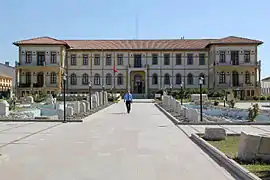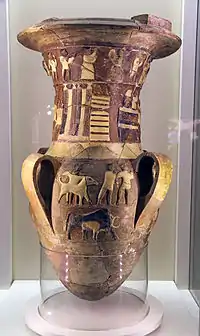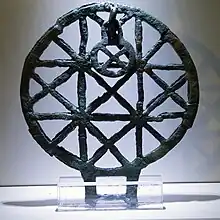Çorum | |
|---|---|
 Çorum Archaeological Museum | |
 Çorum Location in Turkey | |
| Coordinates: 40°32′44″N 34°57′25″E / 40.5455°N 34.957°E | |
| Country | Turkey |
| Province | Çorum |
| District | Çorum |
| Government | |
| • Mayor | Halil Ibrahim Asgin (AKP) |
| Population (2022)[1] | 269,595 |
| Time zone | TRT (UTC+3) |
| Website | www |
Çorum (Turkish pronunciation: [ˈtʃoɾum]) (Medieval Greek: Ευχάνεια, romanized: Euchaneia) is a northern Anatolian city in Turkey. Çorum is located inland in the central Black Sea Region of Turkey, and is approximately 244 km (152 mi) from Ankara and 608 km (378 mi) from Istanbul. It is the seat of Çorum Province and of Çorum District.[2] Its population is 269,595 (2022).[1] The city has an elevation of 801 m (2,628 ft) above sea level.
Çorum is primarily known for its Phrygian and Hittite archaeological sites, its thermal springs, and its native roasted chick-pea snacks known nationally as leblebi.
History
There is ample archaeological evidence for human presence in the area since the Paleolithic ages.[3] The area prospered during the Bronze Age, with the emergence of the Hittite Empire between 1650-1200 BC. Hattusa, the Hittite capital, was located in the region owing to its inherent geographic protection, and the well-established local economy as supported by the regional Karum system.[3]
There is a hypothesis that the Byzantine town of Euchaneia was at or near the site of the modern city, but others place Euchaneia further east, at Euchaita. In Ancient Greek sources, Çorum was known as Niconia (Nikonya), and in the Byzantine period known as Evkaite.[4]



The settlement of Çorum proper can be traced only to the 16th century. The name is of unknown origin, and is first attested in Ottoman records, in reference to a Seljuk fortress Çorum Kalesi described by Evliya Çelebi. In the mid 16th century, the fortress was divided into four mahalle or quarters. From 1867 until 1922, Çorum was part of Angora vilayet.
In 1915, its Armenian population was killed during the Armenian genocide.[5] In 1917, during the Greek genocide, Çorum became a deportation area for Greeks from Samsun. Many died from starvation, cold, and deadly infectious diseases. Survivors were then deported to Çankırı or Ankara.[5]
Çorum today


The town today is generally tidy and pleasant, with a locally popular countryside. As with most Central Anatolian and inland Black Sea towns, the population is largely conservative, leading to a generally more restricted nightlife that favors dry establishments, although there are some bars, pubs and cafés that offer a mix of contemporary and traditional Turkish folk music. Within the city, there is a good range of shops, cafés and restaurants, with a cuisine that includes a variety of pastries including the nationally-known Çorum Mantısı - a popular dish similar to ravioli that is slowly baked in a brick oven or steamed in a beef broth. As well as the archeological and other historic sites, the countryside surrounding Çorum offers many places for picnics, particularly near the Çomar reservoir or in the mountains around the province.
The old Ottoman houses, the 19th century clock tower, and the Çorum Museum that displays a range of artefacts from excavations in the region are popular tourist interests. An International Hittite Congress of archaeologists is held in Çorum every three years.
Economy
Although the economic output of the city has historically been relatively small with a focus on traditional crafts like coppersmithing, tanning, hand weaving, agriculture and animal husbandry, over the past two decades, the city has shown a significant growth in industrial production and light engineering that has made it among the most industrially advanced cities compared to its population size.
Originally home to about 20 tile and brick manufactories and 10 flour and feed mills, the city today produces a wide variety of products ranging from cement to automobile parts, refined sugar to dairy products, textiles to computer parts, and more recently, poultry through chicken farming.[6]
Demographics
On the eve of the First World War, 3,520 Armenians lived in the kaza of Çorum: 1,020 in Çorum proper, 1,500 in Ekrek, 400 in Alaca, and the rest in Bozok and Hüseyinabad.[5] Males were cut to death with axes by çetes supervised by Nureddin Pasha as part of the Armenian genocide.[5] There were Greek inhabited settlements around Çorum (Τσορούμ/Tsoroum), including Çorum itself.[5]
| Population of the city of Çorum | |
|---|---|
| 2017 | 227,863 |
| 2009 | 206,600 |
| 2000 | 161,321 |
| 1990 | 116,810 |
| 1985 | 96,725 |
| 1980 | 75,726 |
| 1970 | 57,576 |
Geography
Çorum is on the northern edge of the Central Anatolian Plateau. There is an attractive mountainous countryside around the city. The North Anatolian Fault line passes 20 km (12 mi) south of Çorum.
Climate
Çorum has a warm summer continental climate (Köppen climate classification: Dfb or Trewartha climate classification: Dcb) with dry summers and cold, snowy winters, and mild to cool wet springs and autumns with light rain.
| Climate data for Çorum (1991–2020, extremes 1929–2021) | |||||||||||||
|---|---|---|---|---|---|---|---|---|---|---|---|---|---|
| Month | Jan | Feb | Mar | Apr | May | Jun | Jul | Aug | Sep | Oct | Nov | Dec | Year |
| Record high °C (°F) | 20.6 (69.1) |
20.4 (68.7) |
28.6 (83.5) |
30.4 (86.7) |
35.1 (95.2) |
37.5 (99.5) |
42.6 (108.7) |
40.2 (104.4) |
38.7 (101.7) |
33.6 (92.5) |
25.6 (78.1) |
19.2 (66.6) |
42.6 (108.7) |
| Mean daily maximum °C (°F) | 4.6 (40.3) |
7.4 (45.3) |
12.5 (54.5) |
17.9 (64.2) |
22.9 (73.2) |
26.8 (80.2) |
30.2 (86.4) |
30.7 (87.3) |
26.7 (80.1) |
20.7 (69.3) |
12.9 (55.2) |
6.5 (43.7) |
18.3 (64.9) |
| Daily mean °C (°F) | −0.2 (31.6) |
1.4 (34.5) |
5.6 (42.1) |
10.4 (50.7) |
15.0 (59.0) |
18.7 (65.7) |
21.7 (71.1) |
21.9 (71.4) |
17.8 (64.0) |
12.5 (54.5) |
5.6 (42.1) |
1.6 (34.9) |
11.0 (51.8) |
| Mean daily minimum °C (°F) | −4.1 (24.6) |
−3.5 (25.7) |
−0.3 (31.5) |
3.4 (38.1) |
7.4 (45.3) |
10.7 (51.3) |
12.8 (55.0) |
13.1 (55.6) |
9.6 (49.3) |
5.7 (42.3) |
0.2 (32.4) |
−2.2 (28.0) |
4.4 (39.9) |
| Record low °C (°F) | −25.6 (−14.1) |
−27.2 (−17.0) |
−23.3 (−9.9) |
−9.4 (15.1) |
−4.3 (24.3) |
0.2 (32.4) |
3.4 (38.1) |
3.0 (37.4) |
−3.0 (26.6) |
−6.3 (20.7) |
−15.7 (3.7) |
−21.6 (−6.9) |
−27.2 (−17.0) |
| Average precipitation mm (inches) | 37.4 (1.47) |
28.5 (1.12) |
42.0 (1.65) |
46.6 (1.83) |
61.7 (2.43) |
63.5 (2.50) |
21.4 (0.84) |
19.0 (0.75) |
24.9 (0.98) |
27.9 (1.10) |
32.9 (1.30) |
43.0 (1.69) |
448.8 (17.67) |
| Average precipitation days | 12.30 | 10.57 | 13.57 | 13.73 | 15.77 | 12.00 | 5.10 | 4.10 | 6.60 | 8.43 | 8.70 | 12.37 | 123.2 |
| Mean monthly sunshine hours | 68.2 | 98.9 | 145.7 | 192.0 | 235.6 | 267.0 | 316.2 | 310.0 | 246.0 | 173.6 | 117.0 | 62.0 | 2,232.2 |
| Mean daily sunshine hours | 2.2 | 3.5 | 4.7 | 6.4 | 7.6 | 8.9 | 10.2 | 10.0 | 8.2 | 5.6 | 3.9 | 2.0 | 6.1 |
| Source: Turkish State Meteorological Service[7] | |||||||||||||
Twin towns – sister cities
Notable natives
- Mahmut Atalay - World champion and Olympic medalist wrestler
- Tevfik Kış - World champion and Olympic medalist wrestler
- Cevdet Cerit - professor of mathematics at Istanbul Technical University
- Komet or Gürkan Coşkun - Famous Turkish artist
- Soner Yalçın - Famous Turkish journalist, arrested for Ergenekon trials
- İbrahim Kaypakkaya - Founder of Türkiye Komünist Partisi/Marksist-Leninist
- İsmail Beşikçi - Writer
- Aşık Gülabi (Gülabi Gültekin) - Minstrel
- Gen. Ahmet Çörekçi - Former Head Commander of the Turkish Air Force
- Savaş Yurderi Kool Savas - a German rapper and hip hop artist
See also
References
- 1 2 "Address-based population registration system (ADNKS) results dated 31 December 2022, Favorite Reports" (XLS). TÜİK. Retrieved 13 March 2023.
- ↑ İlçe Belediyesi, Turkey Civil Administration Departments Inventory. Retrieved 1 March 2023.
- 1 2 History of Çorum Archived 2009-03-17 at the Wayback Machine
- ↑ Christopher Walter, The Warrior Saints in Byzantine Art and Tradition (2016), citing Hippolyte Delehaye (1909).
- 1 2 3 4 5
- ↑ Economy of Çorum Archived 2009-03-17 at the Wayback Machine
- ↑ "Resmi İstatistikler: İllerimize Ait Mevism Normalleri (1991–2020)" (in Turkish). Turkish State Meteorological Service. Retrieved 28 June 2021.
External links
- Pictures of the city with links to surrounding Hittite sites
- Chisholm, Hugh, ed. (1911). . Encyclopædia Britannica. Vol. 6 (11th ed.). Cambridge University Press. p. 270.

